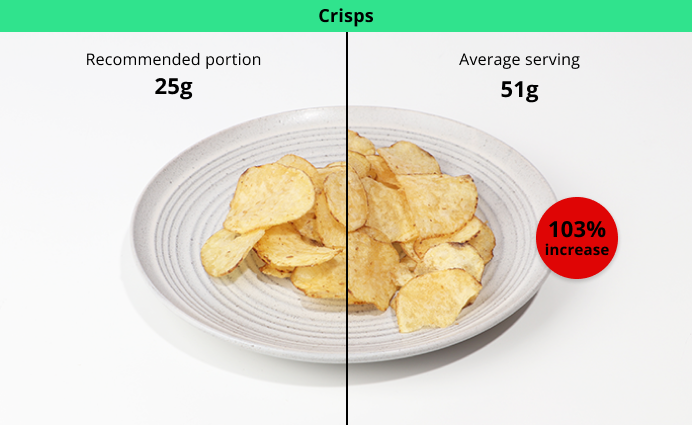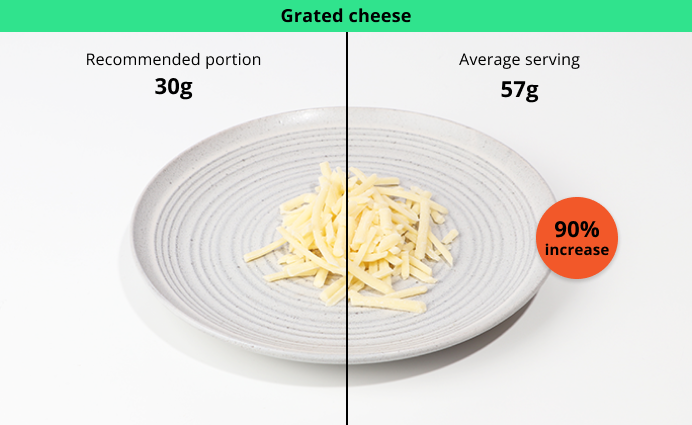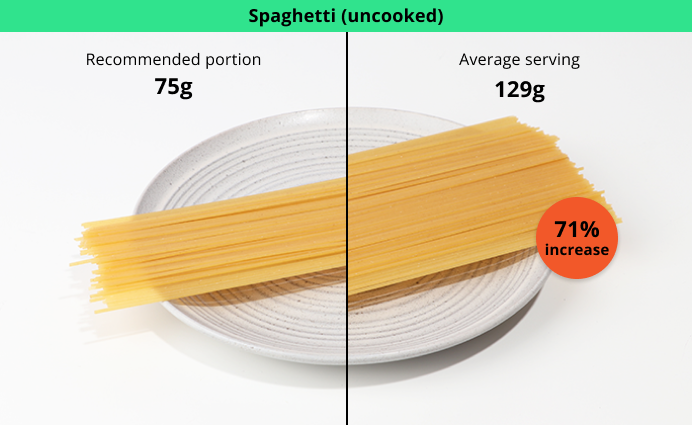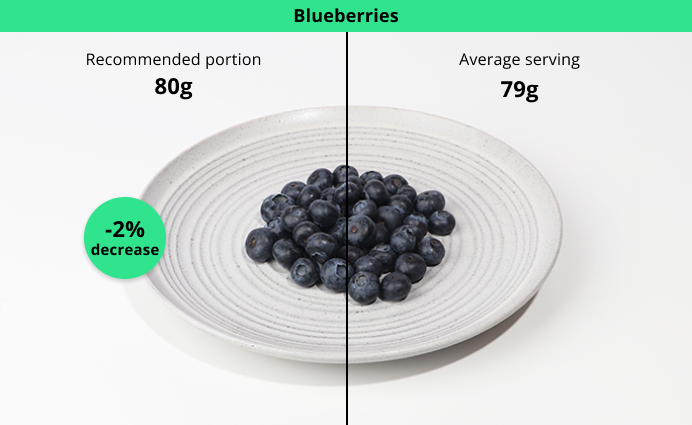Knowing your portion sizes
Content warning: This page contains material related to food portion sizes that may not be suitable if you have had or continue to have an eating disorder.
Eating a healthy balanced diet and maintaining a healthy weight is as much about food quantity as quality. This means how much you eat as well as what you eat. But how many of us know what a recommended portion size looks like?
To find out, we conducted a social experiment asking 71 UK adults to serve themselves what they estimated to be a recommended portion of common foods and drinks. We then analysed the averages and compared them to the recommended serving sizes.
We also asked nutritionist, Vinny Kodamala, to explain the health impacts of mis-portioning.
“A food portion is the amount of food you eat in one serving. It’s important to be aware of portion sizes. Eating too much or not enough of any type of food can increase your risk of health problems.
“Too much saturated fat and salt can increase your risk of heart disease and stroke. Whilst too much sugar can lead to weight gain and tooth decay.”
89% of portions were larger than the recommended serving size
Data from our study revealed that 89% of the 19 foods and drinks were over-portioned. The only exceptions were wine, which was just 3ml shy of a 175ml standard glass and blueberries which were under by just a gram.
The three most over-portioned items
1. Chocolate
It may come as no surprise to hear that chocolate was the most over-portioned item. A recommended portion of chocolate is 4 small squares or 20g but we’re eating three times more than this. The average serving was 12 squares (60g) with participants’ servings ranging from 2 squares (8g) to 46 squares (184g).
“Chocolate is a high-calorie food which is high in sugar and saturated fat. While delicious, it’s not essential to our diets and should be enjoyed only as a treat, less often and in smaller amounts.”
2. Dried apricots
Dried apricots were next on the list, where on average, participants served themselves almost triple the recommended portion of 30g.
“While gram for gram, dried apricots have more fibre, carotenoids and protective plant chemicals versus fresh apricots, they are naturally high in sugar and are higher in calories. For this reason, just 30g counts as one of your five-a-day.”
3. Gin
Gin was also concerningly over-poured. When asked to serve themselves a 25ml measure, on average, participants served themselves 53ml - more than double the recommended measure.
“With portions of this size, participants would be consuming more than double the amount of calories and units of alcohol. While there’s no completely safe level of drinking, the NHS recommends no more than 14 units of alcohol per week, spread across at least three days.”
How do these differences look on a plate?

















How incorrect portion sizes impact nutritional value
“If you’re concerned you’re not meeting government dietary recommendations, you’re not alone. Recent research shows most people in the UK eat and drink too many calories, too much fat, sugar and salt, and not enough fruit, vegetables, oily fish or fibre.
“In fact, a conservative government estimate suggests most adults are eating 200 to 300 more calories than recommended each day. And it’s not hard to see why. We are constantly being persuaded to buy and eat more food through food advertising, promotions and access to restaurants and cafés.”

“The traffic light labelling system that you find on the front of a lot of food packaging was introduced by the government in 2014 to improve public health. It’s designed to give you an immediate indication of whether something is low (green) or high (red) in terms of fat, sugar and salt.
“But traffic light labelling is only useful if you’re eating the recommended portion size. And, manufacturers can be sneaky in terms of what they say is a portion, making it easy to overeat.
“For example, if you look carefully, a grab bag of crisps may be labelled as two portions. But the packaging is not resealable so you assume it’s one portion, and eat the whole bag. The traffic light label tells you you’re consuming 20% of your daily fat allowance. But because you’ve got the portion size wrong, it’s double that at 40%.
“Even over-portioning fruit and veg could be an issue. It’s recommended that everyone eats a variety of at least five portions of fruit and vegetables daily. Because different fruits and vegetables contain different combinations of nutrients, this means different types.”

The public are turning to Google for advice
We looked at search data to see which foods the UK public is most unsure about when it comes to portioning. These are the top 20 foods and drinks people are turning to Google for information about recommended portion sizes:

“Google searches reveal people are looking for guidance about how much pasta and rice to serve per person. Unfortunately, there’s not one simple answer because it depends on whether you’re portioning it out before or after you’ve cooked it.
“The Association of UK Dietitians (BDA) suggest 75g of dry pasta (or spaghetti) per person. This is roughly two to three tablespoons. But pasta absorbs water during cooking and almost doubles in weight so a cooked pasta portion size will weigh about 150g.
“A recommended dry rice portion per person is 50g (around two to three tablespoons). However, boiled rice triples in weight meaning if you’re portioning rice after cooking, 150g per person is suggested.”
Incorrect portion sizes could lead to weight gain and lifelong conditions
“The key to eating a balanced diet is to eat a wide variety of foods in appropriate amounts. If your portions are too big, it will be harder to control your weight. Overeating certain foods can also put you at risk of serious lifelong medical conditions such as type 2 diabetes.”
Tips for portion control
Overestimating portion sizes is one of the main issues that can hamper weight loss success. Nutritionist Vinny shares her tips for healthy portion control:
1. Check food labels
“Make sure you know what portion size the nutrition information on your food packaging relates to. It may be different to the amount you’re eating.”
Read our guide on how to read a food label.
2. Use smaller dinnerware
“Evidence suggests the size of the bowls, plates and glasses we eat and drink from can unconsciously influence how much we eat. Using large plates, for example, can lead to overeating. Try reducing the size of your plates, bowls and even serving spoons to reduce the amount you're putting on to your plate."
3. Portioning your snacks
“Eating directly from large packages can lead to mindless eating, overeating and less awareness of appropriate portion sizes. Pouring a portioned amount of your snack into a bowl reduces the chance of going back for more.”
4. Weigh your food
“Many people who are trying to lose weight find that weighing their food helps them to understand how much they’re eating and how many calories they’re having.”
5. Use measuring utensils
“Understandably, some people find weighing out food inconvenient. Measuring food by volume may be easier. You can either use measuring cups and spoons, or a portion size guide.”
6. Use your hands for measuring
“If you’re ever without food scales or measuring utensils, your hands can be used as a rough portion control guide. Protein portions should be the size of your palm, carbs should be limited to the size of a clenched fist and fats should be index finger-sized.”
7. Stretch your favourite recipes
“You can still make the recipes you love while on your weight loss journey. Try making five portions out of a recipe that serves four, for example. You could bulk out the meal by serving vegetables on the side.”
8. Avoid serving dishes on the table
“Having serving dishes on the dinner table can tempt you to go back for a second helping. Serve yourself at the kitchen counter and put any leftovers in a container straight away to avoid temptation.”
9. Eat mindfully
“Studies have shown eating while you’re distracted can mean you miss the physical and visual cues that you’ve had enough to eat, leading to overeating. Avoid mindless eating by taking a break from your phone and not watching TV while you eat.”
10. Be cautious when eating out
“Supersized portions can be hard to avoid when you’re eating out and it’s easiest to avoid temptation if the food isn’t on your plate to start with. If your goal is weight loss, ask for a smaller portion or say no to high-calorie sides like the bread basket or fries.”
If you are overweight or have a raised BMI and need help losing weight, we can prescribe treatment such Mounjaro® and Wegovy® to support you on your journey. If our clinicians deem weight loss injections or weight loss pills suitable, they’ll check your BMI and you can either have your treatment delivered to your door.
References
https://www.bbcgoodfood.com/howto/guide/top-10-health-benefits-of-apricots
https://www.nhs.uk/better-health/drink-less/
https://www.nhs.uk/live-well/eat-well/food-guidelines-and-food-labels/how-to-read-food-labels/
https://assets.publishing.service.gov.uk/media/5cd414fc40f0b6604ae7d35b/Calories_Evidence_Document.pdf
https://patient.info/news-and-features/is-the-food-traffic-light-labelling-system-useful
https://www.nhs.uk/live-well/eat-well/5-a-day/portion-sizes/
https://www.nhs.uk/live-well/eat-well/5-a-day/why-5-a-day/
https://www.bda.uk.com/resource/food-facts-portion-sizes.html
https://patient.info/news-and-features/how-big-is-a-portion
https://www.eufic.org/en/healthy-living/article/how-to-measure-portion-sizes-with-your-hands
https://www.ncbi.nlm.nih.gov/pmc/articles/PMC3607652/





